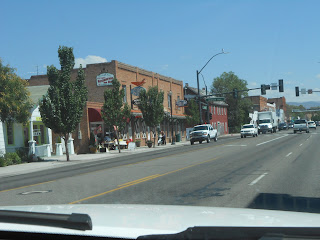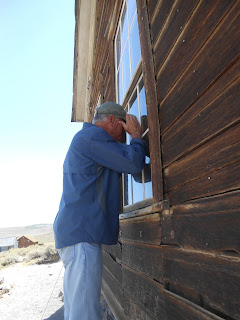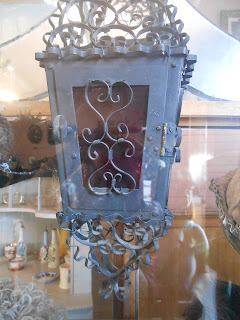 |
| No, it's not a mirage. |
Traveling south from Susanville, California we shot through Reno and its "Hot August Nights" festival then quickly found ourselves south of town in Carson City, Nevada. Just as quickly we spied our Mother Church: COSTCO! And for us, that meant one thing: cheap gas. After paying as much as $5 a gallon in California, Costco Nevada gas was $3.31 a gallon. We gassed up the Prius, had some lunch and down the road along the eastern slope of the Sierra mountains we went.
...through the clean and delightful little town of Gardinerville...
Highway 395 south of Carson City is among the most scenic and rewarding road trips you can take in the U.S., especially in late spring or early fall. Heading south along the eastern slope of the Sierras you have mountains scraping the sky to your right and to your left, lakes and low desert. Not far from each other is the lowest point in the continental United States -- parts of Death Valley at 200 feet below sea level -- and the highest point, Mount Whitney at around 14,500 feet. Sandwiched in between is another superlative: the oldest trees on earth in the bristlecone pine forest of the White Mountains. And you'll have to buy some of the world's most expensive gas to get there.
If you're an RVer, especially with one of these monster big rigs, in the peak summer months you should make RV park or campground reservations well in advance since spaces fill up fast. Get a California RV park guide at visitor centers, WalMarts, Camping Worlds or online. And the same is true if you plan to stay in a motel. Remember, you're competing with traffic up from L.A., down from Reno and San Francisco and over from Las Vegas. So if you don't want to sleep out under the stars with rattlesnakes, scorpions, gila monsters, tarantulas, and gangbangers, plan ahead.
This is what John Muir referred to as the "Range of Light", the shining granite peaks of the high sierras along 395. Is this country wonderful or what?
About fifty miles south of Carson City you cross back into California and like I just mentioned, more ridiculously high gas prices (more about that in our next post). About two or so hours south of Carson City, you roll into the small community of Bridgeport, the jumping off spot for one of the most memorable side trips you will ever take.
This is the road to the old mining/ghost town of Bodie, California, 17 miles off Highway 395. The first fourteen miles are paved with a 55 mile-per-hour speed limit. The last three miles are unpaved, rough, dusty, and bone jarring.
But this rocky road is designed to get you into the mood of what you're about to enter.
Here's the Prius braving the last three miles along with hundreds of other brave souls every day. So don't think you can't do it. If the Prius can make it, so can you.
At the end of the road once you pick up your false teeth and the old lady stops screaming, you are well rewarded. This is Bodie, now a California State Park.
This is an old silver and gold mining camp that sprang up in the 1860s and operated through the 1920s. The California State Parks system maintains it in a state of arrested decay. It's not a Disneyland-like theme park where everything is a recreation. This is the real thing. Or what's left of the real thing.
At one point Bodie boasted a population of 15,000 and Mark Twain, Harpers Magazine, and the Police Gazette had a field day writing about the raucous, wicked nature of this little piece of hell. It was reported that every night there was a shooting, along with prostituting, gambling, and, oh yeah, miners actually working and pulling some fifty million dollars of ore out of the ground. In today's dollars that would be a gazillion or two.
Here's the big wheel by an even bigger wheel. But since it's his Prius and Lance 1885 travel trailer with side slide I have to stick this in. Paul doesn't know it but they're actually mine and Daisy's. We just humor him with the occasional shot.
Here we are, the actual owners of the aforementioned trailer and Prius, wandering and wondering about Bodie. What's most interesting about this is the old mining junk and 1880s bric-a-brac is scattered about just as the miners left it when they abandoned this place around 1930. Yeah, no question, the state park has probably staged some of it but never mind, just enjoy what you see.
Here we are violating one of the park rules but we just had to stage Daisy on the rusted chassis of an old something or other. What the hell, she's the reason for our trailer travels. If it wasn't for her we'd be sailing the high seas, climbing the Great Wall or punching Putin in the face and hauling back that teabaggin', Fox News-viewin' traitor Snowden.
Bodie in its heyday was a such a notorious place that a little girl from the East who moved there with her parents wrote, "Goodbye, God, I'm going to Bodie." But one of the town's three newspapers, the Bodie Free Press changed the copy to read, "Good, by God, I'm going to Bodie." We were told that the little girl grew up to become the silent film star Fay Wray. Or not.
This gives you some idea of what they mean by "arrested decay". Large timbers prop up buildings that otherwise would be a pile of wooden rubble.
Here's something of a sorry ass commentary on many Americans and our travel habits (or lack thereof). The day we were at Bodie many if not most of the visitors were Europeans. They love the open spaces of the United States, especially the wild, wild West that they have heard so much about. And they travel more than any population of people on the planet, including the Japanese. It is said of the Europeans that they live in small houses and take big vacations. Why the hell can't we do the same? Well, in our case, because of Daisy. But we do live in a small house. It's called a "trailer".
This is looking through the window of an old dilapidated house. The wallpaper and paint have actually peeled off the walls. The weather here in Bodie takes an incredible toll. At more than 7,000 feet elevation, heavy snow and high winds pummel the town in winter while scorching sun bakes it in the summer. Throw in rain, rattlesnakes and gangbangers and the park system has its hands full keeping up.
This is a shot through the window of the last remaining saloon. At one time Bodie had more than thirty saloons that doubled as shooting galleries. When tempers flared, which was often, gunmen would drop their pool cues, duck behind the pool table and start firing.
Only five percent of Bodie's buildings remain. Only five percent. Fire, extreme weather and early souvenir hunters claimed the other 95 percent.
It's reported in this saloon there were no fewer than fourteen murders. Oh yeah, prove that ain't true. So multiply that times thirty and you got a whole lot of burying to do.
Oh yes, and there was one church. It's one of the best preserved buildings. Don't think there were too many shootins here.
And the other best preserved building is the current ranger's house. So don't go trying to snag any souvenirs cuz they got their eye on ya. You are asked to leave everything where it lies. If you pick something up, put it back where you found it.
If you don't make motel reservations in advance, this could be where you wind up. Of course, everyone in Bodie had an outhouse and Paul likes to point out that he grew up in an antebellum* house in tiny Wyoming, Illinois with an outhouse, no running water in the house and a wood-burning stove. But he adds it was a character-builder. After all, he went on to become the Chairman of the Joint Chiefs of Staff under Jimmy Carter. Or was it Jimmy Durante? Or Jiminy Cricket? Oh yeah. And I became the Pope.
* "antebellum" means "before the war" (ante: before, bellum: war). In this case it refers to a house built before the American Civil War.
Bodie did have bathtubs and most likely plenty of well water but what this is doing sitting out in the open is anybody's guess. I think the house around it fell apart and the cast iron tub was the only thing left.
And like you'll find at the Winchester Mystery House in San Jose, here's a staircase to nowhere. Actually, this was at one of the houses of prostitution, the door boarded up to keep Paul out.
And no frontier mining town was complete without its Chinese population. The Chinese brought opium and just about everyone smoked it.
This is Rosa May, the daughter of Irish immigrants who actually made good and became one of Bodie's most popular citizens and a long employed prostitute. In the Bodie town census she was listed as a "seamstress", code word for "hooker".
True to form, Rosa and the girls would hang a red light (seen here) to tell their clients that they were open for business, so to speak.
The notorious "red light" may have originated with railroad employees who would hang their red lanterns outside houses of prostitution while they went inside for a little fun. Don't know if that's true but it sounds plausible.
Among the other most prosperous businesses in town was undertaking. Of course, everyone dies but here death was rather premature and an almost daily occurrence.
Ornate, horse-drawn hearses would haul you off to one of the boneyards on the hill. These hearses are inside a small museum that gives you some perspective on what it is you're seeing scattered about town.
This is looking down what's considered the main street in Bodie. As crowded as it appears today, again, only five percent of Bodie remains. This had to be one boomin' place back around the turn of the twentieth century.
This to me is something Bodie could do without--this is clearly recreated and kept in a state of "repair"--the old gas station and a refurbished truck. But the horseless carriage was a part of Bodie's later history and there are almost as many junked cars as there are buildings.
We never put these photos in order but this is yet another old interior and yes, we think that's a baby carriage on the left.
And like every town of any size around the turn of the century, you dumped your garbage in a garbage dump. Nobody collected it and took it to a landfill. This is Bodie's garbage dump. I suppose five hundred years from now all traces of it will be history. Gone. But so will I.
And this is an even bigger wheel with a much humbled little wheel.
Something we found interesting: the state has brought in cadaver-sniffing dogs to find out where Bodie's bodies are buried. At the time gunmen, murderers, prostitutes (including Rosa May) and illegitimate children were buried outside the walls of the main cemetery. These dogs are trying to find remains so they can be relocated inside the cemetery. Methinks times and attitudes have changed.
The point of this ramble is to goad you into seeing this place. In 2013 the entry fee is $7 for adults and the printed guide a couple of bucks extra. It's a rewarding, educational experience and for photographers and artists (such as our good friend and talented artist Suzi), there is more opportunity for still photography and painting than you'll find almost anywhere.
In our next few posts, land of Ted Nugent/Sarah Palin devotees, the spot where evildoer Charles Manson was indicted, Manzanar and movie sets, and finally, hotter than hell attractions in Death Valley.
Bye bye. Buy Starbucks. Best damn coffee in the world.






































No comments:
Post a Comment
Keep it clean, please. And nice. And complimentary.